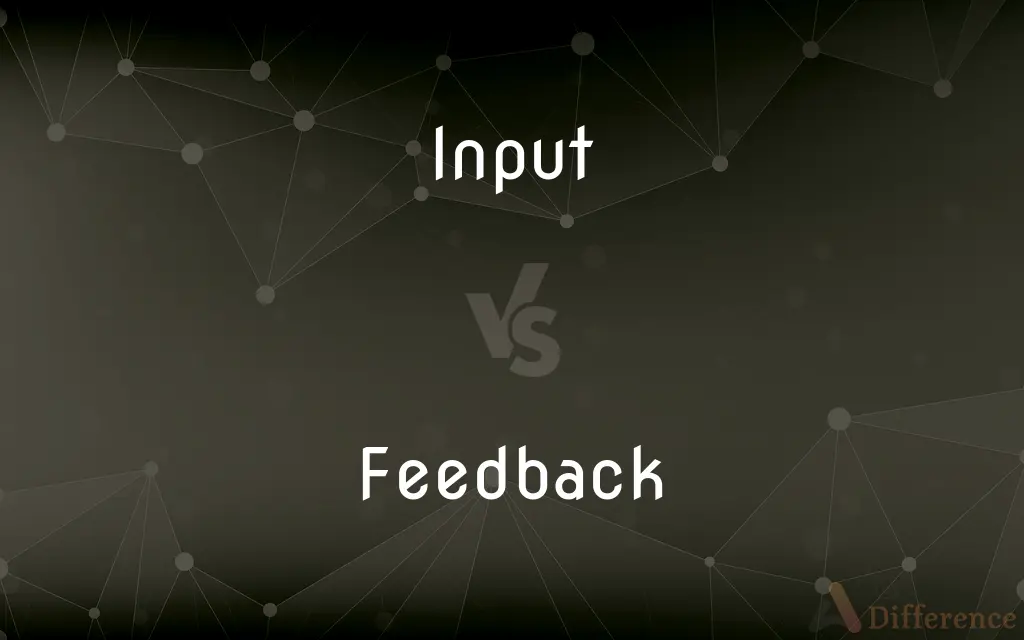Input vs. Feedback — What's the Difference?
By Urooj Arif & Maham Liaqat — Updated on April 23, 2024
Input is information provided for processing, while feedback is a response to output or performance.

Difference Between Input and Feedback
Table of Contents
ADVERTISEMENT
Key Differences
Input consists of data or information fed into a system for processing or consideration, fundamental in initiating tasks or processes. Feedback, however, is the information or reactions returned after the processing of input or performance of a task, aimed at improving or modifying future actions. Input is the starting point that influences or directs actions, whereas feedback acts as a guiding mechanism, offering insights or evaluations on those actions.
While input is crucial for beginning any process, offering the necessary information or instructions, feedback is essential for the iterative improvement of processes, systems, or individual performance. Feedback can be positive or negative and is instrumental in learning, development, and optimization efforts. On the other hand, input can vary widely in form and purpose, including raw data, instructions, or resources needed to achieve a particular outcome.
Input plays a key role in the design and operation of systems, where specific information is required to initiate operations. In contrast, feedback is a critical component of control systems, where it is used to adjust, refine, or correct the ongoing processes based on the outcomes achieved. This loop of action and reaction, facilitated by input and feedback, is fundamental in dynamic systems, including technological, educational, and organizational contexts.
In educational settings, for example, input might consist of instructional materials, student participation, or assignment tasks provided by educators. Feedback, meanwhile, could be the evaluations, corrections, or encouragements offered in response to student submissions or performances, guiding learning and improvement. This distinction highlights the complementary but distinct roles of input and feedback in fostering growth and achieving objectives.
The relationship between input and feedback is cyclical and interactive; input leads to actions whose outcomes are evaluated through feedback, which then influences future input. This cycle is crucial for continuous improvement, adaptation, and success in various endeavors, emphasizing the interdependence of these concepts in achieving goals and fostering development.
ADVERTISEMENT
Comparison Chart
Definition
Information provided for processing
Response to output or performance
Purpose
To initiate or direct a process
To guide, improve, or adjust actions
Role
Fundamental for starting processes
Essential for iterative improvement
Form
Can be data, instructions, resources
Often evaluations, reactions, insights
Application
Design and operation of systems
Control and improvement of processes
Compare with Definitions
Input
Contributions or information provided for a specific purpose.
He provided valuable input during the brainstorming session.
Feedback
Information regarding the results of a process or activity.
The teacher's feedback on the essays helped students improve.
Input
Initial information that influences or directs action.
The input from the sensor triggered the alarm system.
Feedback
A mechanism for control or adjustment in systems.
The thermostat uses temperature feedback to maintain the setting.
Input
A component or factor that contributes to a process.
Her expertise was a critical input in the research study.
Feedback
Evaluative information used for future adjustments.
The pilot project's feedback was used to tweak the final plan.
Input
Data or signals entered into a system for processing.
The programmer entered the input for the new software feature.
Feedback
Positive or negative responses to outputs.
The positive feedback from the audience was encouraging.
Input
Resources, effort, or information provided to achieve an outcome.
The project required input from various departments.
Feedback
Reactions or responses that aim to enhance performance.
Customer feedback led to significant product improvements.
Input
What is put in, taken in, or operated on by any process or system
There is little input from other members of the team
Data input
Feedback
Feedback occurs when outputs of a system are routed back as inputs as part of a chain of cause-and-effect that forms a circuit or loop. The system can then be said to feed back into itself.
Input
A place where, or a device through which, energy or information enters a system
The signal being fed through the main input
Feedback
The return of a portion of the output of a process or system to the input, especially when used to maintain performance or to control a system or process.
Input
Put (data) into a computer
Test results can be inputted by the technician in the laboratory
Feedback
The portion of the output so returned.
Input
Energy, work, or power used to drive a machine.
Feedback
Sound created when a transducer, such as a microphone or the pickup of an electric guitar, picks up sound from a speaker connected to an amplifier and regenerates it back through the amplifier.
Input
Current, electromotive force, or power supplied to an electric circuit, network, or device.
Feedback
The return of information about the result of a process or activity; evaluative response
Asked the students for feedback on the new curriculum.
Input
Information put into a communications system for transmission or into a computer system for processing.
Feedback
The process by which a system, often biological or ecological, is modulated, controlled, or changed by the product, output, or response it produces.
Input
Any of the items, including materials, equipment, and funds, required for production.
Feedback
Critical assessment of a process or activity or of their results.
After you hand in your essays, I will give both grades and feedback.
Input
The act of putting in; infusion
A steady input of fuel.
Feedback
The part of an output signal that is looped back into the input to control or modify a system.
Input
An amount put in.
Feedback
The high-pitched howling noise heard when there is a loop between a microphone and a speaker.
Input
Contribution of information or a comment or viewpoint
A discussion with input from all members of the group.
Feedback
(music) To generate the high-frequency sound by allowing a speaker to cause vibration of the sound generator of a musical instrument connected by an amplifier to the speaker.
The show ended with a riot of feedbacking guitars.
Input
To enter (data or a program) into a computer.
Feedback
(transitive) To provide informational feedback to.
His employees feedbacked him a lot more than he wanted.
Input
The act or process of putting in; infusion.
Feedback
(transitive) To convey by means of specialized communications channel.
Customers feedbacked their complaints and some praise.
Input
That which is put in, as in an amount.
Feedback
The process in which part of the output of a system is returned to its input.
Input
Contribution of work or information, as an opinion or advice.
You can provide input via this form.
Feedback
Response to an inquiry or experiment.
Input
Data fed into a process with the intention of it shaping or affecting the output of that process.
Sound input
Feedback
The process in which part of the output of a system is returned to its input in order to regulate its further output
Input
(electronics) An input jack.
Model with A/V input
Feedback
Response to an inquiry or experiment
Input
(transitive) To put in; put on.
Input
(transitive) To enter data.
The user inputs his date of birth and the computer displays his age.
Input
(transitive) To accept data that is entered.
Input
Signal going into an electronic system
Input
Any stimulating information or event; acts to arouse action
Input
Enter (data or a program) into a computer
Common Curiosities
What forms can feedback take?
Feedback can be verbal or written evaluations, quantitative data, reactions, or any form of response that provides insight into performance or outcomes.
Can input affect the quality of feedback?
Yes, the quality and relevance of input can significantly affect the quality of feedback, as appropriate and clear input can lead to more targeted and useful feedback.
Why is input important?
Input is crucial because it provides the necessary information or resources to start or guide a process towards its intended outcome.
How do input and feedback function in a learning environment?
In a learning environment, input includes instructional materials and activities provided to students, while feedback consists of evaluations, corrections, and guidance offered in response to student work, facilitating learning and improvement.
What role does feedback play in customer satisfaction?
Feedback plays a critical role in customer satisfaction by allowing businesses to understand customer experiences, preferences, and issues, leading to improvements in products, services, and customer care.
Is input always data or information?
While input often consists of data or information, it can also include resources or efforts provided to achieve a specific purpose.
What is the difference between input and feedback?
Input is the information or resources provided to a system or process to initiate action, while feedback is the response or evaluation given after an action is completed, aimed at guiding future improvements.
How does feedback contribute to improvement?
Feedback contributes to improvement by providing insights, evaluations, or reactions that can be used to make adjustments, enhance performance, or refine processes.
Can feedback serve as input?
Yes, feedback can serve as input in a cyclical process where the response to an action informs and improves subsequent actions.
How are input and feedback utilized in project management?
In project management, input consists of resources, information, and efforts needed to execute a project, while feedback involves responses and evaluations related to the project’s progress, outcomes, and team performance, guiding future actions and decisions.
How do technological systems use input and feedback?
Technological systems use input to process data or perform actions based on user commands or sensor data, while feedback mechanisms adjust operations, maintain conditions, or provide users with information about the system’s status.
What challenges can arise in the feedback process?
Challenges in the feedback process can include receiving vague or irrelevant feedback, timing issues, or resistance to feedback, which can hinder its effectiveness in promoting improvement or change.
What makes feedback effective?
Effective feedback is specific, actionable, timely, and relevant, offering clear guidance on how to improve or adjust actions for better outcomes.
How can input be optimized to improve outcomes?
Input can be optimized by ensuring it is relevant, accurate, comprehensive, and tailored to the needs of the process or system, enabling more efficient and effective operations.
Why is feedback considered essential in performance management?
Feedback is essential in performance management because it provides employees with information on their performance, highlighting strengths and areas for improvement, and guiding professional development and growth.
Share Your Discovery

Previous Comparison
Cart vs. Basket
Next Comparison
Puncture vs. HoleAuthor Spotlight
Written by
Urooj ArifUrooj is a skilled content writer at Ask Difference, known for her exceptional ability to simplify complex topics into engaging and informative content. With a passion for research and a flair for clear, concise writing, she consistently delivers articles that resonate with our diverse audience.
Co-written by
Maham Liaqat













































